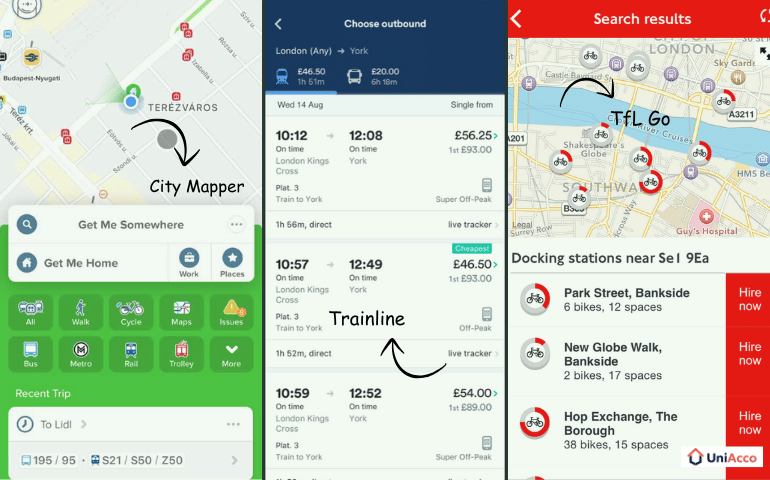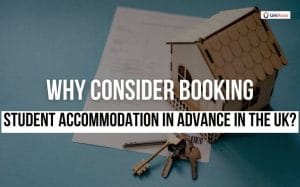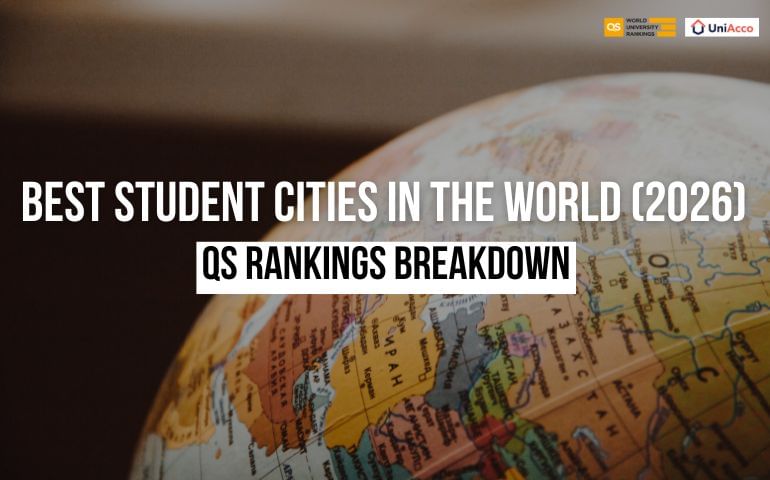Whether you have just arrived in the UK for university or are a few weeks into your course, figuring out how to get around is key to student life.
The good news? The UK has a super reliable and student-friendly public transport system that makes commuting to campus, exploring the city, or planning weekend getaways a breeze.
From hopping on the Tube in London to catching a train to your next adventure or using budget-friendly buses, getting from A to B is easier than you would expect.
In this guide, we will break down all the public transport options to help you travel smart, save money, and settle in with confidence.
Modes Of Transport In The UK
The UK offers a wide range of public transport options that are reliable, efficient, and student-friendly. Whether you are commuting within the city or travelling cross-country, there’s a mode of transport to suit every need and budget.
1. Buses
One of the most common and affordable ways to get around cities and towns. Local buses run frequently and cover a vast network. In cities like London, you can pay with an Oyster card or a contactless card, making it hassle-free.
2. Trains (National Rail Services)
For longer journeys between cities, trains are a fast and scenic option. Operated by various companies, they connect major cities like London, Manchester, Birmingham, Edinburgh, and beyond. Booking in advance often gets you cheaper fares.
3. London Underground (The Tube)
The iconic Tube is the quickest way to get around London. With 11 lines and easy-to-follow maps, it’s well-suited for students and tourists alike. Use an Oyster card or contactless for quick entry and exit.
4. Trams & Light Rail
Several cities like Manchester, Sheffield, and Nottingham operate efficient tram services. They are great for short-distance city travel and often connect residential areas to the city centre.
5. Coaches (Long-Distance Buses)
Operators such as National Express and Megabus offer affordable intercity travel. Though slower than trains, they are ideal for budget-conscious students.
6. Taxis & Ride-Hailing Apps
Traditional black cabs are available in most cities, but ride-sharing apps like Uber, Bolt, and FreeNow are more popular among students due to their ease of use and pricing.
7. Bicycles & E-Scooters
Many UK cities offer public bike-sharing schemes like Santander Cycles in London or Beryl Bikes in towns like Norwich and Hereford. E-scooters are also gaining popularity in areas with approved trials.
Please check local rules before riding.
Must-Have UK Public Transport Apps

Whether you are planning your first Tube ride or catching a train to a new city, having the right transport apps can save you time, money, and stress.
Here are some of the best public transport apps in the UK that make getting around easier, smarter, and way more convenient:
Citymapper
Citymapper is a go-to app for city travel in the UK, especially for students. Simply enter a postcode or location, and it instantly displays the fastest, cheapest, and most convenient ways to get there, whether by bus, Tube, train, walking, cycling, or Uber. You will get live timings, route maps, fare estimates, and real-time updates, making it super easy to plan your journey across cities like London, Manchester, Birmingham, and Glasgow.
Trainline
Trainline is perfect for planning and booking train or coach travel across the UK. Enter your departure and destination stations, and the app displays train times, platform information, fare options, and even cheaper ticket combinations. You can book e-tickets, track real-time delays, and use railcards to get student discounts all in one place.
TfL Go (Transport for London)
TfL Go is the official app for navigating London’s public transport. Whether you’re taking the Tube, buses, trams, or DLR, it provides live service updates, step-free access information, and personalised route suggestions based on real-time traffic. You enter your destination, and TfL Go handles the rest – ideal for daily commuters and first-time London visitors.
National Express App
If you are travelling between UK cities on a budget, the National Express app helps you plan and book coach journeys quickly. It shows you routes, timings, seat availability, and fare options in real-time. You can store tickets digitally, get journey alerts, and enjoy flexible booking options all at student-friendly prices.
Railcard App
The Railcard app lets you store and use your discount card digitally no need to carry the physical one. It helps students and young adults save 1/3 on train fares across the UK. You can also check train routes, renew your card, and track savings directly in the app.
Santander Cycles / Beryl / Voi / Lime
These city-specific apps make renting bikes and e-scooters super simple. Just locate a nearby bike or scooter, unlock it with the app, and start riding. You will see cost estimates, parking zones, and ride duration. Great for short, sustainable trips in cities like London, Norwich, and Bristol.
Travelling Around London
Navigating London can be overwhelming for first-time visitors due to its extensive network of stations, lines, and bus stops. But once you get the hang of it, public transport in London is one of the most efficient in the world.
Here’s a breakdown of the main ways to travel around the capital:
London Underground (The Tube)
The London Underground, commonly known as the Tube, is the fastest way to travel long distances across the city. It has 11 colour-coded lines and over 270 stations, connecting Central London to the outer boroughs.
- Trains typically run from 5:00 AM to 12:30 AM, with Night Tube services on select lines (Central, Victoria, Jubilee, Northern, Piccadilly) on Fridays and Saturdays.
- Some stations in central areas (like Covent Garden and Leicester Square) are so close that walking is often quicker.
- Use Oyster cards, contactless cards, or mobile payment for the best fares paper tickets are more expensive.
- Always tap in and tap out at barriers even if they’re open, to avoid being charged the maximum fare.
Buses
London’s red double-decker buses are a city icon, covering nearly 700 routes across 19,000+ stops and reaching areas not served by the Tube.
- Many routes operate 24/7, including Night Buses that run when the Tube is closed.
- Cash is not accepted; pay using Oyster, contactless, travelcard, or mobile payment apps.
- A single fare is £1.75, with unlimited bus and tram transfers within one hour under the Hopper Fare scheme.
- Buses are a great way to see the city above ground—ideal for budget-friendly sightseeing.
Docklands Light Railway (DLR)
The DLR is a driverless light rail system serving East and Southeast London, including stops like Canary Wharf, Stratford, and London City Airport.
- All stations are step-free, making it fully accessible for wheelchair users, parents with prams, and travellers with luggage.
- Single fares with Oyster/contactless range from £2.70 to £5.60, depending on zones and peak/off-peak timing.
- The DLR is part of the TfL network, so it works with daily caps and Travelcards.
London Overground
The London Overground connects areas of London that the Tube doesn’t, especially in East and South London. Trains run from key stations like Liverpool Street, Victoria, and Waterloo.
- Fully integrated with the Oyster/contactless system.
- Fares and caps follow the same structure as the Tube.
- Always check if your destination is within London fare zones, some Overground stations fall just outside.
By Bike
Cycling is a fun, healthy, and increasingly popular way to travel in London. The city has a growing number of dedicated cycle lanes and low-traffic neighbourhoods.
- Use Santander Cycles (London’s public bike-sharing scheme) for short trips £1.65 for 30 minutes.
- E-bikes are now part of the fleet, with pay-as-you-go pricing.
- Many cycle routes are scenic, taking you past parks, canals, and landmarks.
Travelling Around Other Cities In The UK
Trams and Light Rail Systems
Several cities in the UK operate efficient tram networks, ideal for short city travel:
- Manchester Metrolink: One of the largest tram systems in the UK, covering the city centre and suburbs.
- Nottingham Express Transit (NET): Serves Nottingham and surrounding areas with frequent services.
- Sheffield Supertram: A light rail network connecting Sheffield’s city centre with the university, suburbs, and stadiums.
- Tyne and Wear Metro (Newcastle): Combines features of the Tube and suburban rail, great for getting around Newcastle and Sunderland.
Tram fares vary by zone but are usually between £1.50–£3.50 per journey, with day passes and student discounts available.
City Buses
Every major UK city has a network of local buses, often the most affordable way to travel:
- Operators vary by region (e.g., Stagecoach, Arriva, FirstBus, Lothian Buses in Edinburgh).
- Contactless payments are widely accepted, and most services now run app-based ticketing.
- Fares typically range from £1.80 to £2.50 for a single ride.
- Many cities offer daily caps or student passes (weekly or monthly) for unlimited travel.
Pro tip: Google Maps, Moovit, or the operator’s own app will show live bus times and routes.
Suburban & Local Trains
In larger cities like Birmingham, Leeds, Glasgow, and Liverpool, local rail services connect the city centre with outer suburbs and nearby towns.
- Run by operators like Northern Rail, ScotRail, and West Midlands Trains.
- You can use contactless, railcards, or online tickets (via Trainline or National Rail apps).
- Student railcards (like the 16–25 Railcard) can save you 1/3 on fares.
Cycling and Bike Schemes
Just like London, many cities offer bike-sharing services:
- Beryl Bikes (in Norwich, Bournemouth, Hereford)
- Nextbike (in Cardiff and Glasgow)
- Santander Cycles (Milton Keynes)
Cycling is often the fastest and cheapest way to get around in compact cities, with expanding cycle lanes and dedicated bike paths.
Travelling Between Cities
To get from one city to another, you can use:
- Trains: Fast, comfortable, and widely connected. Book early for the best rates.
- Coaches: National Express, Megabus, and FlixBus offer budget options with student discounts.
Fares vary by distance and time, but coaches often start from £5–£10, while train fares can range from £10–£50+, depending on how early you book and the route.
Whether you are commuting to class, heading out for a weekend adventure, or exploring a new city, the UK public transport system has you covered.
From trains and trams to budget-friendly buses and bikes, getting around is easier than ever, especially with the right apps in your pocket.
And while getting from place to place is sorted, having a comfortable place to come home to matters just as much. That’s where UniAcco comes in.
Find trusted student accommodation in UK, near your university, compare top-rated properties, and book in a few clicks, all in one place.
FAQs
1. Does the UK have a good public transportation system?
Yes, the UK has a well-connected and reliable public transport system, especially in major cities like London, Manchester, and Edinburgh. From buses and trains to trams and bike-sharing schemes, it’s easy to get around without a car.
2. What is the cheapest public transport in the UK?
The cheapest public transport in the UK is typically local buses, especially with the government’s £2 fare cap scheme (extended through 2025 in England). For long-distance travel, coaches like Megabus and National Express often offer fares starting from as low as £5 if booked in advance.
3. What is the best way to travel around the UK as a tourist?
The best way to travel around the UK as a tourist is by train for speed and convenience between major cities, and by coach for a more budget-friendly option. Within cities, use a mix of buses, trams, and walking and don’t forget contactless cards or travel passes for easy access and savings.
4. Is it worth getting a UK bus pass as an international student?
Yes, a UK bus pass is worthwhile for international students who frequently use buses. It offers unlimited travel, student discounts, and saves money compared to single fares.















0 Comments